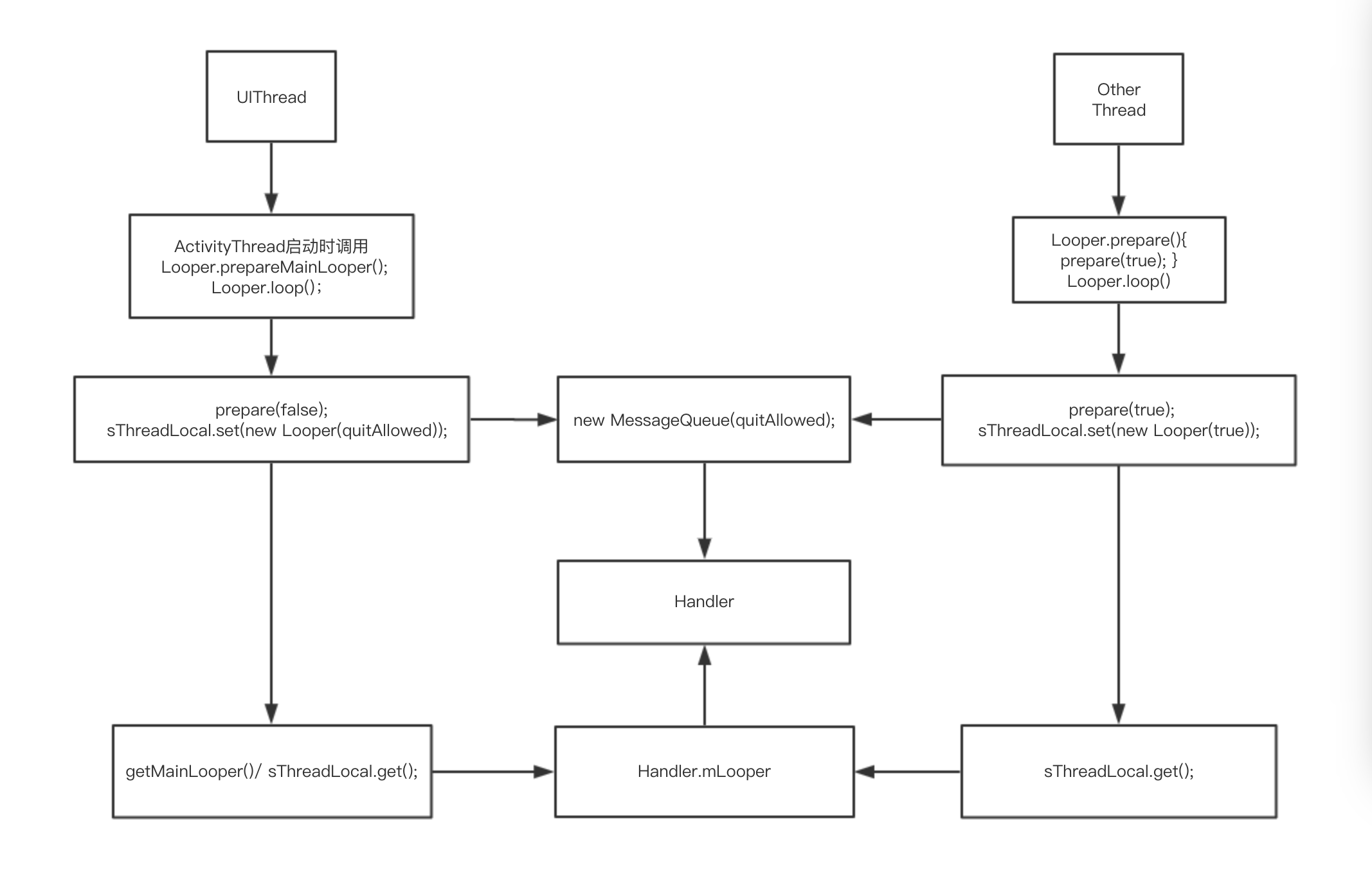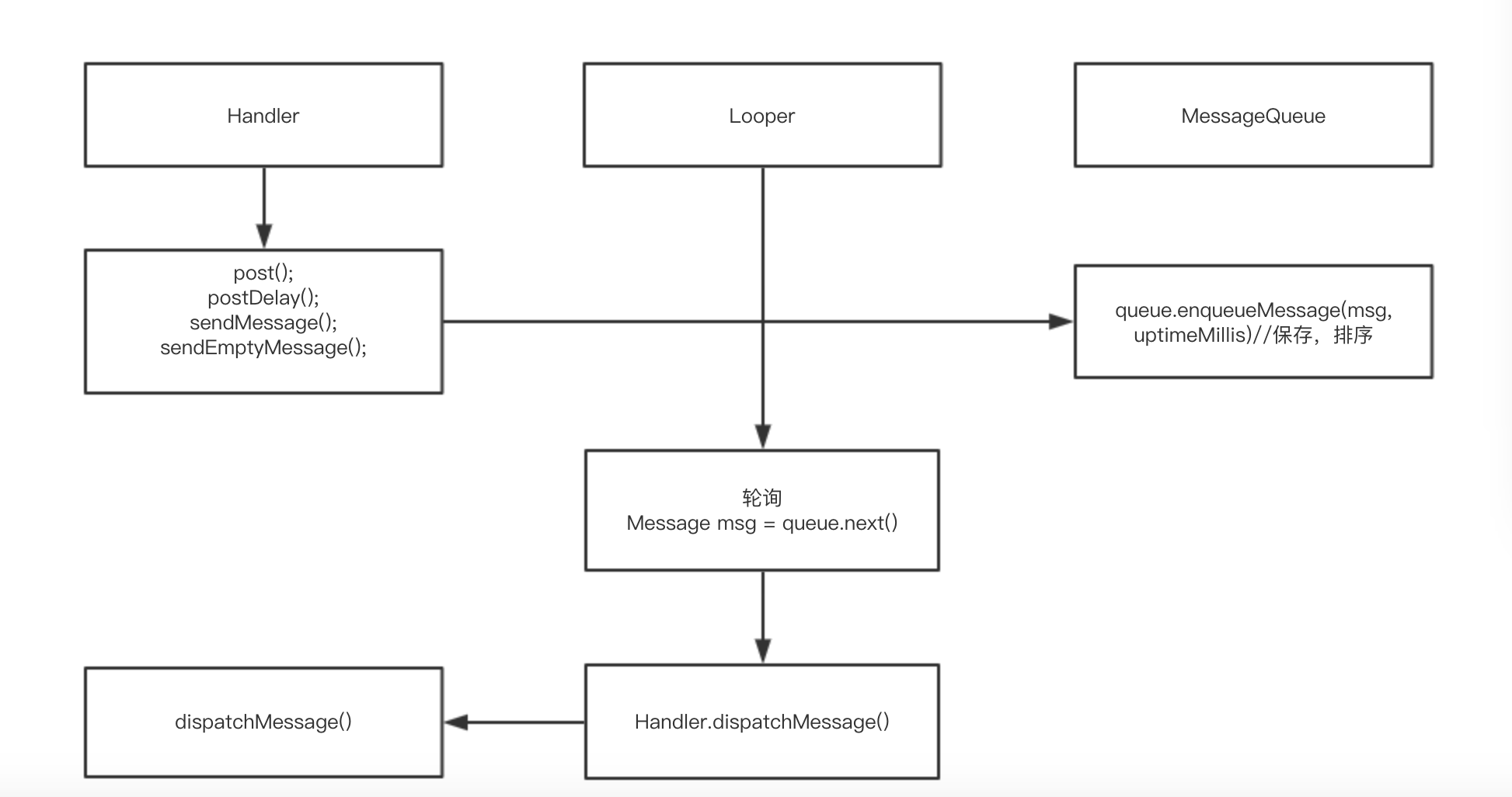Handler、Looper、MessageQueue 初始化
- 1.在 UI 线程创建 Handler,通常直接new Handler;
private Handler mHandler = new Handler() {
@Override
public void handleMessage(Message msg) {
super.handleMessage(msg);
}
}
UI Thread 初始Handler化时 对Looper进行初始化过程, main()是在 UI Thread 启动时调用
```
public static void main(String[] args) {
SamplingProfilerIntegration.start();
CloseGuard.setEnabled(false);
Environment.initForCurrentUser();
EventLogger.setReporter(new EventLoggingReporter());
Security.addProvider(new AndroidKeyStoreProvider());
final File configDir = Environment.getUserConfigDirectory(UserHandle.myUserId());
TrustedCertificateStore.setDefaultUserDirectory(configDir);
Process.setArgV0("<pre-initialized>");
Looper.prepareMainLooper();
ActivityThread thread = new ActivityThread();
thread.attach(false);
if (sMainThreadHandler == null) {
sMainThreadHandler = thread.getHandler();
}
if (false) {
Looper.myLooper().setMessageLogging(new
LogPrinter(Log.DEBUG, "ActivityThread"));
}
Looper.loop();
throw new RuntimeException("Main thread loop unexpectedly exited");
}
```
查看一下代码,主要关注一下:Looper.prepareMainLooper();
```
public static void prepareMainLooper() {
prepare(false);
synchronized (Looper.class) {
if (sMainLooper != null) {
throw new IllegalStateException("The main Looper has already been prepared.");
}
sMainLooper = myLooper();
}
}
public static void prepare() {
prepare(f);
}
private static void prepare(boolean quitAllowed) {
if (sThreadLocal.get() != null) {
throw new RuntimeException("Only one Looper may be created per thread");
}
_ sThreadLocal.set(new Looper(quitAllowed));
_ }
```
以上是UI Thread 初始化new Handler 调用过程
-
2.接下来看一下 Other Thread 初始化调用。
Looper.prepare(); private Handler mHandler = new Handler() { @Override public void handleMessage(Message msg) { super.handleMessage(msg); } }查看下Looper.prepare();
public static void prepare() { prepare(true); } private static void prepare(boolean quitAllowed) { if (sThreadLocal.get() != null) { throw new RuntimeException("Only one Looper may be created per thread"); } _ sThreadLocal.set(new Looper(quitAllowed)); _ }
- 3.其他用法: 在其他地方需要用到Handler,并且需要刷新UI时,不通过Looper.prepare();调用,通过Looper.getMainLooper()也可以;
` Handler mHandler = new Handler(Looper.getMainLooper());
class Looper{
public static Looper getMainLooper() {
synchronized (Looper.class) {
return sMainLooper;
}
}
} `
-
4.MessageQueue 初始化
private Looper(boolean quitAllowed) { mQueue = new MessageQueue(quitAllowed); mThread = Thread.currentThread(); } ``` Looper 在初始化时创建一个关联MessageQueue,一个线程中对应一个Looper & MessageQueue -
Handler 初始化
// 常用构造 public Handler(Callback callback) { this(callback, false); } public Handler(Callback callback, boolean async) { if (FIND_POTENTIAL_LEAKS) { final Class<? extends Handler> klass = getClass(); if ((klass.isAnonymousClass() || klass.isMemberClass() || klass.isLocalClass()) && (klass.getModifiers() & Modifier.STATIC) == 0) { Log.w(TAG, "The following Handler class should be static or leaks might occur: " + klass.getCanonicalName()); } } mLooper = Looper.myLooper(); if (mLooper == null) { throw new RuntimeException( "Can't create handler inside thread that has not called Looper.prepare()"); } mQueue = mLooper.mQueue; mCallback = callback; mAsynchronous = async; } ``` 从这里我们基本可以看到Handler 初始化时,关联了线程唯一的Looper & MessageQueue。 -
UI Thread 和 其他 Thread 初始完Looper和MessageQueue后,会调用Looper.loop(),来轮询分发消息。
-
5.梳理一下调用关系,来张流程图理解一下;
-
UI Thread:
ActivityThread.main() -->Looper.prepareMainLooper() --> prepare(false) --> new Looper(quitAllowed) --> new MessageQueue(quitAllowed) -
Other Thread:
prepare() --> prepare(true) --> new Looper(quitAllowed) --> new MessageQueue(quitAllowed)
-
 Handler-Looper-MessageQueue流程图
Handler-Looper-MessageQueue流程图
异步消息
-
1.调用,存储消息
mHandler.sendMessage(new Message()); mHandler.post(); mHandler.postDelay();追踪一下不难发现,最后都走的一个地方
private boolean enqueueMessage(MessageQueue queue, Message msg, long uptimeMillis) {
msg.target = this;
if (mAsynchronous) {
msg.setAsynchronous(true);
}
return queue.enqueueMessage(msg, uptimeMillis);
}
这样看msg.target = this;msg.target就是Handler自己,而MessageQueue就是Looper中关联的对象,而enqueueMessage()中是对message保存,进行Message.next()按时间排序。
- 2.消费
Looper.loop()是对MessageQueue的消费
public static void loop() {
final Looper me = myLooper();
if (me == null) {
throw new RuntimeException("No Looper; Looper.prepare() wasn't called on this thread.");
}
final MessageQueue queue = me.mQueue;
// Make sure the identity of this thread is that of the local process,
// and keep track of what that identity token actually is.
Binder.clearCallingIdentity();
final long ident = Binder.clearCallingIdentity();
for (;;) {
Message msg = queue.next(); // might block
if (msg == null) {
// No message indicates that the message queue is quitting.
return;
}
// This must be in a local variable, in case a UI event sets the logger
Printer logging = me.mLogging;
if (logging != null) {
logging.println(">>>>> Dispatching to " + msg.target + " " +
msg.callback + ": " + msg.what);
}
msg.target.dispatchMessage(msg);
if (logging != null) {
logging.println("<<<<< Finished to " + msg.target + " " + msg.callback);
}
// Make sure that during the course of dispatching the
// identity of the thread wasn't corrupted.
final long newIdent = Binder.clearCallingIdentity();
if (ident != newIdent) {
Log.wtf(TAG, "Thread identity changed from 0x"
+ Long.toHexString(ident) + " to 0x"
+ Long.toHexString(newIdent) + " while dispatching to "
+ msg.target.getClass().getName() + " "
+ msg.callback + " what=" + msg.what);
}
msg.recycleUnchecked();
}
}
看到loop()中,添加了一个死循环,不断去轮训MessageQueue中的队列是否为null,返回或者取出来继续执行 msg.target.dispatchMessage(msg);在最开始我们看到msg.target就是Handler本身
public static Handler mHandler = new Handler() {
@Override
public void handleMessage(Message msg) {
if (msg.what == 101) {
Log.i(TAG, "接收到handler消息...");
}
}
};
而handleMessage就是我们重写的回调方法。
-
3.一张图梳理一下流程
 流程图
流程图





网友评论